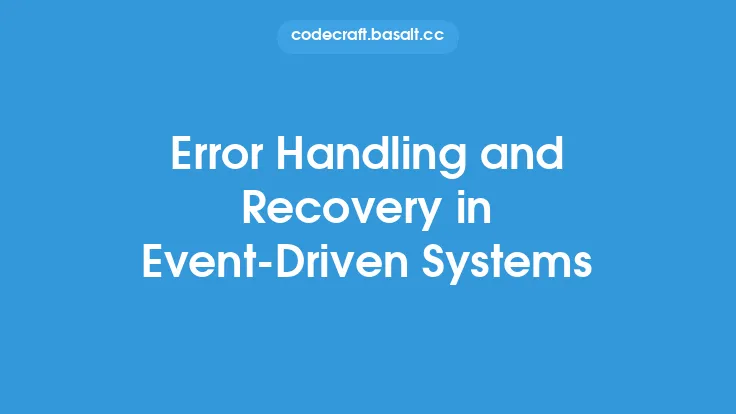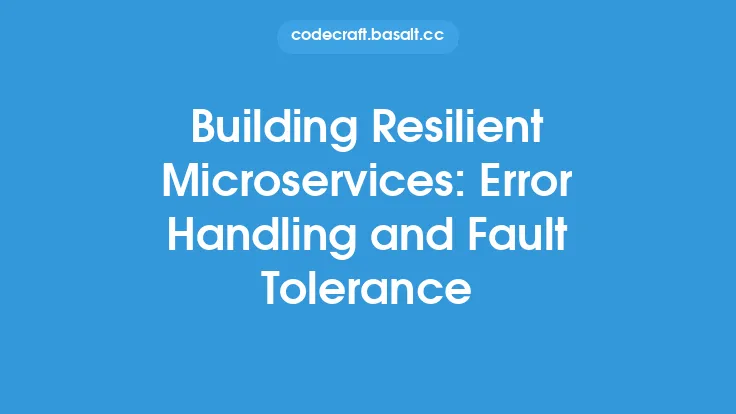When designing and implementing integrated systems, it's essential to consider the potential errors that can occur and how they will be handled. Error handling and logging are critical components of system integration, as they enable developers to identify, diagnose, and resolve issues quickly and efficiently. In this article, we'll delve into the world of error handling and logging in integrated systems, exploring the concepts, techniques, and best practices that can help ensure the reliability and maintainability of these complex systems.
Introduction to Error Handling
Error handling refers to the process of detecting, reporting, and recovering from errors that occur during the execution of a system. In integrated systems, errors can arise from a variety of sources, including software bugs, hardware failures, network issues, and data inconsistencies. Effective error handling is crucial, as it can help prevent system crashes, data corruption, and other catastrophic consequences. There are several key aspects to error handling, including error detection, error reporting, and error recovery. Error detection involves identifying the error and determining its cause, while error reporting involves notifying the system administrators or developers of the error. Error recovery, on the other hand, involves taking corrective action to restore the system to a stable state.
Logging Mechanisms
Logging is a critical component of error handling, as it provides a record of system events, including errors, warnings, and other significant occurrences. Logging mechanisms can be used to track system activity, monitor performance, and diagnose issues. There are several types of logging mechanisms, including system logs, application logs, and security logs. System logs record system-level events, such as startup and shutdown messages, while application logs record events specific to a particular application. Security logs, on the other hand, record security-related events, such as login attempts and access requests. Logging mechanisms can be implemented using a variety of tools and technologies, including log files, logging frameworks, and logging services.
Error Handling Techniques
There are several error handling techniques that can be used in integrated systems, including try-catch blocks, error codes, and exception handling. Try-catch blocks involve wrapping code in a try block and catching any errors that occur in a catch block. Error codes involve assigning a unique code to each error, allowing developers to quickly identify and diagnose the issue. Exception handling involves using a programming language's built-in exception handling mechanisms to catch and handle errors. Other error handling techniques include retry mechanisms, which involve retrying a failed operation, and fallback mechanisms, which involve using a backup system or process in the event of a failure.
Logging Best Practices
When implementing logging mechanisms, there are several best practices to keep in mind. First, logs should be stored in a secure and centralized location, such as a log server or a cloud-based logging service. This allows developers to easily access and analyze log data, and helps to prevent log tampering or deletion. Second, logs should be configured to record the right level of detail, including error messages, timestamps, and user IDs. This helps to ensure that logs are informative and useful, without being overly verbose or difficult to analyze. Third, logs should be regularly monitored and analyzed, using tools such as log analysis software or security information and event management (SIEM) systems. This helps to identify potential issues and detect security threats, and can also help to improve system performance and reliability.
Centralized Logging
Centralized logging involves collecting log data from multiple sources and storing it in a single, centralized location. This can be useful for several reasons, including simplified log analysis, improved security, and enhanced system visibility. Centralized logging can be implemented using a variety of tools and technologies, including log collectors, log forwarders, and log analysis software. Log collectors involve installing software on each system or device to collect log data, while log forwarders involve configuring systems to forward log data to a central location. Log analysis software, on the other hand, involves using specialized tools to analyze and visualize log data, helping to identify trends, patterns, and anomalies.
Distributed Logging
Distributed logging, on the other hand, involves collecting and storing log data in a decentralized manner, using a distributed logging architecture. This can be useful for several reasons, including improved scalability, enhanced reliability, and reduced latency. Distributed logging can be implemented using a variety of tools and technologies, including distributed log storage systems, log messaging queues, and log processing frameworks. Distributed log storage systems involve storing log data in a distributed database or file system, while log messaging queues involve using message queues to collect and process log data. Log processing frameworks, on the other hand, involve using specialized software to process and analyze log data in real-time.
Real-Time Logging
Real-time logging involves collecting and processing log data in real-time, using specialized software and hardware. This can be useful for several reasons, including improved system visibility, enhanced security, and faster issue detection. Real-time logging can be implemented using a variety of tools and technologies, including log streaming software, log processing frameworks, and real-time analytics platforms. Log streaming software involves collecting and processing log data in real-time, using streaming protocols such as Apache Kafka or Amazon Kinesis. Log processing frameworks, on the other hand, involve using specialized software to process and analyze log data in real-time, helping to identify trends, patterns, and anomalies. Real-time analytics platforms, meanwhile, involve using specialized software to analyze and visualize log data in real-time, helping to improve system performance and reliability.
Error Handling and Logging Tools
There are several error handling and logging tools available, including log management software, error tracking software, and application performance monitoring (APM) tools. Log management software involves using specialized software to collect, store, and analyze log data, helping to identify trends, patterns, and anomalies. Error tracking software, on the other hand, involves using specialized software to track and manage errors, helping to identify and diagnose issues. APM tools, meanwhile, involve using specialized software to monitor and analyze application performance, helping to identify bottlenecks, errors, and other issues.
Conclusion
Error handling and logging are critical components of integrated systems, enabling developers to identify, diagnose, and resolve issues quickly and efficiently. By implementing effective error handling and logging mechanisms, developers can help ensure the reliability and maintainability of these complex systems. Whether using try-catch blocks, error codes, or exception handling, there are several error handling techniques that can be used to detect, report, and recover from errors. Similarly, logging mechanisms can be used to track system activity, monitor performance, and diagnose issues. By following best practices, such as centralized logging, distributed logging, and real-time logging, developers can help ensure that their integrated systems are secure, reliable, and performant.





